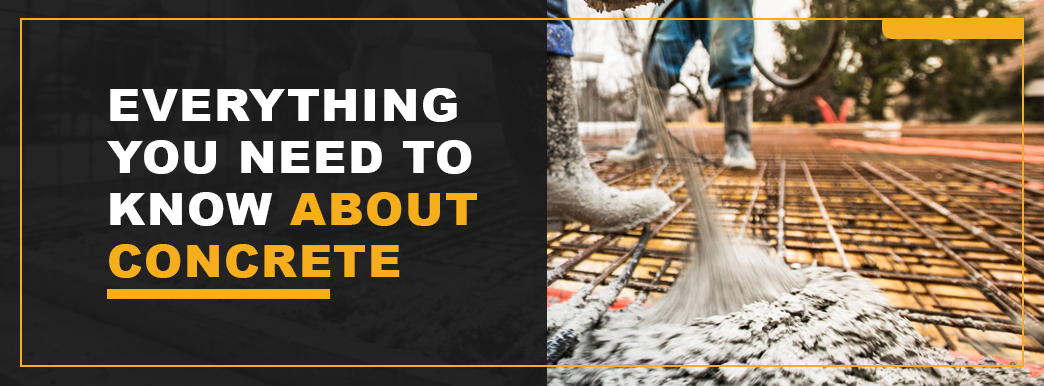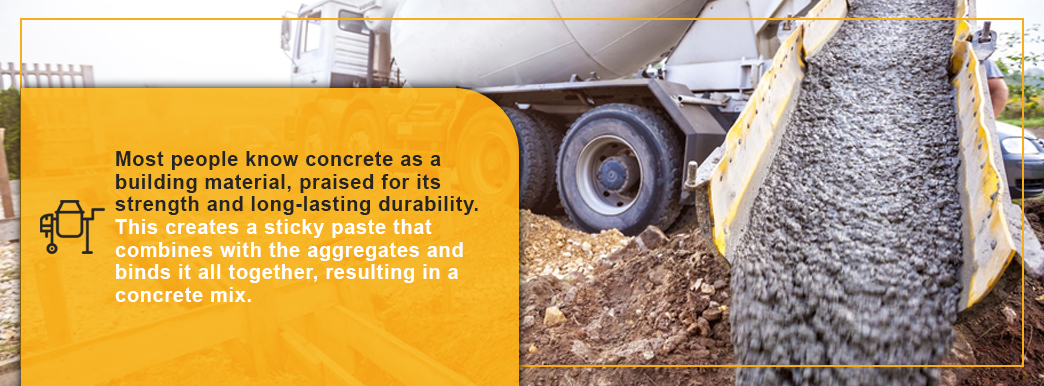
Everything You Need to Know About Concrete
Posted By:Dynamic Concrete Pumping , Date: Oct 29, 2019

With origins dating back to ancient Romans, the history of concrete has shown that it has been a staple material in the world for many, many years. Concrete, known for its durable, long-lasting qualities, can be used for many things. From the foundation of your home to the roads you drive, concrete is everywhere. When it’s freshly mixed, concrete is flexible — it can be molded and shaped to fit almost any project’s needs. When the concrete hardens, it becomes incredibly strong with longevity sure to outlive its competitors. Because concrete is extremely versatile, it remains unmatched by many other materials.
What Is Concrete and What Is It Made Of?
Most people know concrete as a building material, praised for its strength and long-lasting durability. Concrete is not to be confused with cement, though equating concrete to cement is a common misconception. So, what exactly is concrete? What is concrete made of? In simple terms, concrete is a composite material made of three main parts — water, Portland cement and aggregate. How is concrete made? To form concrete, powder form cement mixes with water. This creates a sticky paste that combines with the aggregates and binds it all together, resulting in a concrete mix. It’s not as simple as it sounds, however, and the process has some specific requirements to keep in mind.
1. Water
Water makes up about 20% of the concrete mix and is an essential ingredient to create the necessary paste. The amount of water can help determine the strength of the concrete. For the mix to harden, the water and cement paste crucial for concrete formation must first go through a hydration process. Since Portland cement is a hydraulic cement, it goes through a reaction where nodes form on the surface of each cement particle. Nodes continue to get bigger until they combine with nodes from other cement particles or stick to nearby aggregates. This chemical reaction is only made possible with the water. Depending on the water-cement ratio — which is the weight of the mixing water in pounds divided by the weight of the cement — your concrete could vary in strength. Keeping the water-cement ratio low will result in stronger concrete.
Although water sounds like a simple ingredient, it must meet specific standards before being used in the mix. For example, the water must not have any noticeable taste or smell and be of good enough quality to drink. Water with impurities could impact things such as setting time and overall strength of the concrete. Poor quality water could also cause staining, corrosion or volume instability. In some cases, water may include things like sulfate or alkalis if testing can show how it will affect the concrete. If the chemicals in the water won’t have an overwhelming impact on the concrete, it may be acceptable to use.
2. Portland Cement
Cement makes up about 10 to 15% of the concrete mix and is another crucial player in creating the perfect paste needed for the creation of concrete. Joseph Aspdin, a bricklayer from Leeds, England, first made Portland cement in the early nineteenth century by burning clay and powdered limestone in his stove. Although it’s believed that it wasn’t until the 1870s when the U.S. learned how to create Portland cement, this cement has undoubtedly made its mark on America’s construction industry in recent times. Each year, more than $4 billion worth of hydraulic cement is produced in the U.S. to be used in $20 billion worth of concrete construction.
Portland cement is created by mixing materials made primarily of calcium carbonate and materials containing iron oxide and then burning them until they blend together. The mixture left behind after this process is sometimes referred to as clinker, and is then used to form the Portland cement. The cement is ground into fine powder to be used in the mix to form concrete. Just like water, cement plays a critical role in creating the paste to combine the aggregates and in determining concrete strength.
3. Aggregates
Aggregates — which can be rock, sand or gravel — are granular materials crucial in wrapping up the process needed to produce concrete and account for 60 to 75% of the mix. While aggregate can either be coarse, like gravel or crushed stone, or fine, like sand, the purpose of the concrete ultimately determines the type of aggregate used. When deciding on which aggregates to use in a mixture, look at things such as shape, surface texture, size and skid resistance while remembering the goal of the concrete it’s helping produce.
During the mixture process, aggregates offer something for the paste to stick to. Aggregates combine with the paste and bind together the mixture which is then finally ready for concrete formation. The aggregate should not contain anything that could negatively impact the concrete’s quality. Ultimately, aggregates help to boost the performance of the final concrete product. It’s recommended not to move concrete around too much when doing the final placing to make sure aggregates stay together.
Although concrete is created with just three main ingredients, the mixing process is anything but simple. It’s essential to keep mixes proportionate and combine them carefully to get high-quality concrete that does its intended job. Once the mix is ready to place, it is usually distributed one of three ways — directly from the mix truck, wheeled in with a buggy or pumped in using a concrete boom pump.
Now that you know the concrete creation basics, let’s cover the most popular ways concrete is being used.
Common Uses of Concrete
With concrete’s long-lasting and durable capabilities, it’s no wonder that concrete is all around us in the world today. Without even realizing it, you are probably exposed to concrete numerous times a day, whether it be walking on the street, driving on the highway or going shopping. Taking the time to recognize how prevalent concrete is around you helps you understand the magnitude of its importance and the role it plays in your life. Concrete is commonly used for the following four structures:
1. Buildings and Homes
More and more buildings, specifically houses, are straying away from more traditional materials, such as wood, and are being constructed from concrete. With added strength and durability, a concrete building’s life expectancy will exceed that of its steel or wood-framed counterpart. In fact, the average life expectancy of a wood-frame house is 30 to 50 years on the low end while concrete is expected to last for centuries. A concrete building or home can also better withstand the elements and protect its inhabitants from natural disasters, such as earthquakes, fires or hurricanes. A concrete house can withstand winds of up to 250 miles per hour. You might be wondering does the concrete burn like other building materials? But in a fire, concrete takes much longer to burn than its wood-frame competitor.
A concrete building or home can also conserve more energy than a structure made from traditional materials. Since concrete is naturally insulating, it’s much easier to stay cool indoors during the summer and stay warm in the winter. Concrete can help eliminate draftiness and keep the building at a more consistent temperature. Concrete structures save energy and help save money as a result. In fact, homeowners can expect to save 20 to 25% in annual heating and cooling costs with concrete.
Plus, concrete buildings save their owners money when it comes to durability. Concrete is not subject to degradation the way a wood-framed building would be — there’s no need to worry about costs associated with rot, mold or pesky termites. With the long-lasting capabilities of concrete, it’s also less likely you’ll need to spend money on maintenance and repairs. With the benefits associated with concrete, it’s easy to understand why more people are gravitating toward it when it comes to buildings.
2. Streets
Since America’s first concrete street was constructed in Bellefontaine, Ohio, in 1891, concrete has become a go-to option for streets. Because of concrete’s long-lasting reputation and generally low cost, it has expanded and been used for more and more streets all over the country. Concrete streets save money when it comes to maintenance — since concrete is known as an extremely durable material, maintenance can be performed less frequently. Additionally, streets made from concrete are good at reflecting the sun and heat. Concrete overlays, which place a layer of concrete on top of the preexisting road, are being used to restore old asphalt paving at an affordable level.
3. Highways
The early twentieth century introduced the first concrete highways, which rapidly expanded across America. The first concrete highway was constructed in 1913, and by the next year, 2,348 miles of road was paved with concrete. America’s first major turnpike and toll road — the Pennsylvania Turnpike — was also created with concrete in the 1930s. During the 1930s and 1940s, the U.S. saw significant advancements that helped speed up the process of concrete paving, make it more affordable and enhance durability. Since then, more recent advancements have made it possible to help restore America’s 46,876-mile interstate system to increase its life expectancy while keeping traffic disruption low.
Through the use of high-early-strength concrete in fast-track concrete pavement technology, workers can move quickly and get roads back open faster. This fast-track concrete can cure and reopen roadways in 12 hours compared to conventional concrete, which could take five to 14 days just to cure. Dowel retrofitting is another relatively new method that takes existing roadways and inserts steel bars into pavement joints with cut slots in the road. After that, slots are patched with fast-track concrete mixes and roads are ground to a smooth surface. With dowel retrofitting, years can be added onto existing roadways while making them as smooth as new.
4. Airports
According to the National Air Traffic Controllers Association, there are 71,500 flights handled daily in the U.S. With people continually traveling in and out of airports, it’s vital that they’re traveling safely. Concrete has been a staple material for pavement when it comes to runways, taxiways and apron areas at airports. In fact, concrete was first constructed for airport use during 1927 and 1928 where it made its debut in Dearborn, Michigan, at the Ford Terminal.
Since concrete is heavy-duty, it can withstand different climate conditions and remain strong with substantial aircraft constantly taking off and landing, making it an excellent option for airports. Concrete pavement also reduces worry about interruptions or delays due to maintenance and repairs because concrete is sturdy and long-lasting, so airports can continue to function at capacity and get people where they need to go safely.
Your Concrete FAQs, Answered
Here are answers to three of the most common questions about concrete.
1. Is Concrete Porous?
Yes, concrete is porous.
To understand concrete, you need to understand porosity and permeability. Porosity refers to the volume of openings, called pores, in any given material — in this case, concrete — and compares it to the total volume of the material. Permeability looks at how easy it is for any fluids to pass through the porous material. With concrete, the pores are extremely small holes in the paste created to form concrete.
Gel pores are tiny pores in the glue around the aggregate and are harmless. Capillary pores are the bigger pores that are determined by the concrete mix’s water-cement ratio. If too much water is still in the mix following the cement hydration, capillary pores form and can sometimes even be interconnected. While porosity is to be expected when it comes to concrete, measures can be taken to prevent permeability. You want to keep capillary pores under control to keep permeability low.
To reduce permeability, check the mix to ensure the water-cement ratio is low. For strong concrete that can help keep water out, it is recommended to use a maximum 0.45 water-cement ratio. If your water-cement ratio exceeds 0.50, permeability significantly increases. Another way to keep permeability low is to limit cement content in the mix. Having a richer concrete mix creates a finished product with extremely low permeability. Some may even opt to supplement things such as fly ash or slag to increase the density of the concrete. Aggregates could also have an effect on the permeability of concrete. It’s important to consider the different grades of concrete and use well-graded aggregates and to keep aggregate moisture in mind to prevent excess surface water that would make your concrete more porous. Concrete is porous, but that doesn’t mean it has to be permeable.
2. Is Concrete Waterproof?
No, concrete is not waterproof.
Although water is one of the three main ingredients in the mix to create concrete, water can also damage concrete, an otherwise seemingly indestructible material. Concrete is typically impermeable by liquid water. However, small water particles can still manage to find their way into concrete surfaces. Due to its porous surface and cracks that could form over time, water can permeate concrete and ultimately cause unwanted damage.
One way water can damage concrete is through freeze-thaw disintegration, where water seeps into concrete during the winter months and freezes. When the freezing water expands, some of the concrete chips off. Deicing salts may accelerate this issue and make it worse over time. Soil water can be another potential threat to concrete, especially when it comes to foundations. Wet soil surrounding concrete foundations can lead to damp interiors, which may cause mold. The wet soil could also lead to structural concerns, as the soil may shift or lose strength underneath the concrete foundation.
Given the threats water imposes to your concrete, it’s essential to take steps to protect it. To keep large concrete structures such as foundations dry, make sure there is proper drainage in place to move water away from the base. Depending on your structure’s needs, you may consider dampproofing or waterproofing. Dampproofing should be considered for any concrete foundation to deter moisture, but waterproofing may be needed in environments with more rainfall or high water tables.
3. Is Concrete Homogeneous or Heterogeneous?
Concrete is heterogeneous.
By definition, heterogeneous means made of different components. When referring to a mixture, this means the mixture is not the same throughout. Homogeneous, on the other hand, then refers to mixtures that are uniform throughout regardless of where it’s sampled. While all components in a homogeneous mix are proportionately present, samples taken from a heterogeneous mix could be of different proportions.
Examples of homogeneous mixtures include common household chemicals, like vinegar or dishwashing soap, while something like a chocolate chip cookie is an example of a heterogeneous mix. While you may use the same cookie recipe every time you make them, it’s not guaranteed that on any given bite, you will get the same exact number of chocolate chips.
Think about this in terms of concrete. Just like the cookie is made using specific ingredients, there are specific ingredients to be used in concrete production — water, cement and aggregate. But the ingredients aren’t mixed evenly. Sampling different parts of the mix will yield different proportions of those ingredients. Just as some parts of a chocolate chip cookie have more or less chocolate chips than other parts, some sections of concrete will have more or less aggregate than other sections. Therefore, concrete is heterogeneous.
Choose Dynamic Concrete Pumping for Your Concrete Construction Needs
Given its versatility, strength and long-lasting abilities, it’s no wonder concrete is one of the best materials available. Are you dreaming of starting a concrete project? No matter your end goal, concrete can get you there, and our expert team of concrete contractors can assist you. Contact Dynamic Concrete Pumping to learn more about how our equipment and services can fast track your concrete construction project and watch your plans come to life!



